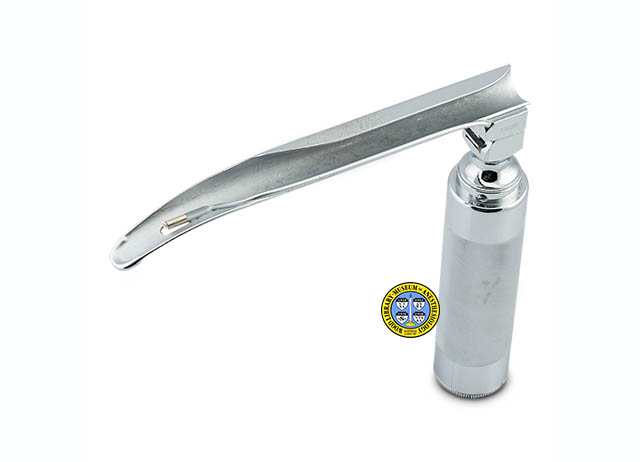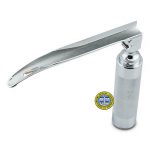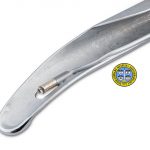Intress Laryngoscope
Anesthesiologists are responsible for maintaining the patient's respiration during surgery. They may use a laryngoscope to guide a breathing tube through the patient's larynx (voice box) into the trachea (wind pipe.) American Anesthesiologist Robert H. Intress, M.D. (1921-2012) was first a general practitioner before taking post-graduate training in anesthesiology. He worked as an anesthesiologist for thirty years. After retiring from the specialty, he worked again as a general practitioner for the Indian Health Service.
Dr. Intress described his new laryngoscope blade in 1955. It is a modification of the popular Miller laryngoscope, introduced in 1941. The design of the Intress blade relocates the battery-operated lightbulb from the edge of the blade to the center, providing more light. This protected position also eliminated pressure on the bulb which could cause the light to blink. The Intress laryngoscope was made by New York's Foregger Company from 1955 through 1959.
Catalog Record: Intress Laryngoscope Intress Laryngoscope
Access Key: aqso
Accession No.: 2000-01-10-1 E
Title: [Intress laryngoscope / invented by Robert H. Intress] ; Foregger Company]
Author: Intress, Robert H. (Harlan), 1921-2012.
Corporate Author: Foregger Company.
Title variation: Alt Title
Title: Miller laryngoscope, Intress modification.
Publisher: Roslyn, New York : Foregger Company, [between 1955 and 1959].
Physical Description: 1 laryngoscope : metals, glass ; 20 x 4 x 21 cm
Subject: Anesthesia, Inhalation – instrumentation.
Subject: Laryngoscopes – battery-powered.
Subject: Laryngoscopes – straight blades.
Subject: Laryngoscopy.
Note Type: General
Notes: The first year in the range of possible dates of manufacture is the date of introduction. The second year in the date range is based on the date of the last Foregger catalog to include this device.
Described from the perspective of the user, with the blade at the top facing the patient, and the threaded base at the bottom.
Note Type: Citation
Notes: Andazola M. Dr. Robert H. Intress: doctor never lost passion for general medicine. Albuquerque Journal. March 15, 2012. https://www.abqjournal.com/94130/doctor-never-lost-passion-for-general-medicine.html. Accessed February 12, 2018.
Note Type: Citation
Notes: Foregger Company. Catalog No. 12. New York: Foregger Company, 1955:132.
Note Type: Citation
Notes: Foregger Company. Catalog No. 15. New York: Foregger Company, 1959:127.
Note Type: Citation
Notes: Intress RH. A modified Miller laryngoscope. Anesthesiology. September, 1955; 16(5):812.
Note Type: Citation
Notes: Spidle JW. Interview with Robert H. Intress, MD (1921-2012), transcript of an oral history conducted May 26, 1989 by Jake W. Spidle. New Mexico Health Historical Collection, UNM Health Sciences Library, University of New Mexico, Albuquerque, New Mexico. http://econtent.unm.edu/cdm/ref/collection/nmhhc/id/11. Accessed January 2, 2018.
Note Type: Physical Description
Notes: One laryngoscope; Consists of a large straight blade (perhaps size 6 or 7) and a snap-on handle; The blade has a snap-on hub that allows the blade to be folded flat against the handle; The blade is straight, with a curved tip that is thickened at the proximal end; The curve begins approximately 7 centimeters from the proximal end; The trough of the blade is flattened on top; The flattened portion covers approximately half the width of the trough;
The conduit that holds the wire for the battery-operated light is attached on top of the left-hand edge of the blade; This conduit curves inward to the bottom of the trough, placing the proximal tip of the bulb approximately 3 centimeters from the proximal tip of the blade; There is a small opening, called a fenestration, in the bottom of the trough, directly under the lightbulb;
The blade alone measures approximately 3.5 x 2.25 x 20 centimeters; The hub of the blade is marked on the left side: “FOREGGER”; The right side of the hub it is marked: “MILLER [new line] INTRESS”; The bottom of the hub is marked: “PATENT [new line] PENDING”;
The handle alone measures approximately 17.5 centimeters in height x 3.75 centimeters in diameter; The handle is built to hold two size D batteries; A threaded cap screws into the base of the handle; A spring is attached to the inner side of the cap; The handle is marked: “FOREGGER FOLDING SCOPE [new line] U. S. PAT 2289226”.
Note Type: Reproduction
Notes: Photographed by Mr. Steve Donisch, January 16, 2018.
Note Type: Acquisition
Notes: Gift of the inventor, Robert H. Intress, M.D.
Note Type: Historical
Notes: Anesthesiologists are responsible for maintaining the patient’s respiration during general anesthesia. They may use a laryngoscope to guide a breathing tube through the patient’s larynx (voice box) and into the trachea (wind pipe.) American Anesthesiologist Robert H. Intress, M.D. (1921-2012) was a native of Iowa. He received his medical degree from the University of Iowa, served in the U. S. Army, then worked as a general practitioner in New Mexico before moving to Texas for post-graduate training in anesthesiology. He worked as an anesthesiologist for thirty years, first in Texas and then in New Mexico. After retiring from the specialty, he worked again as a general practitioner for the Indian Health Service.
Dr. Intress described his new laryngoscope blade in 1955. It is a modification of the popular Miller laryngoscope, introduced in 1941.The design of the Intress blade relocates the battery-operated light from the edge to the center of the blade. The inventor stated, “Central placement of the light has given a brighter field and better definition of the larynx”, adding that this protected position also eliminated pressure on the lightbulb which could cause blinking. The Intress laryngoscope was made by New York’s Foregger Company from 1955 through 1959.
Note Type: Exhibition
Notes: Selected for the WLM website.



